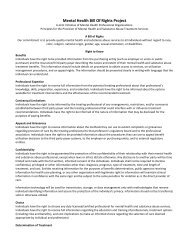2008 Ohio Psychologist - Ohio Psychological Association
2008 Ohio Psychologist - Ohio Psychological Association
2008 Ohio Psychologist - Ohio Psychological Association
You also want an ePaper? Increase the reach of your titles
YUMPU automatically turns print PDFs into web optimized ePapers that Google loves.
Abstract<br />
Positive Psychology and Positive Therapy:<br />
Implications for Practitioners<br />
By: Christopher Mruk, PhD<br />
By now, most psychologists have heard about positive psychology. However, what distinguishes this approach from<br />
others may not be clear to many of us. This article attempts to achieve some clarity by examining three important<br />
dimensions of positive psychology. The first involves taking a brief look at the origins of positive psychology in<br />
order to understand why it has emerged. The second is to consider the chief characteristics of positive psychology in<br />
order to appreciate its focus. The third is to consider two examples of positive therapy in order to show how positive<br />
psychology may be of practical value to the clinician.<br />
By now, most psychologists have heard about something<br />
called positive psychology. However, many of us may not<br />
be quite sure what the term means or what implications it<br />
holds for clinical work. A brief look at the origins of positive<br />
psychology, its chief characteristics, and two examples<br />
of how positive therapy may be helpful to clinicians are<br />
presented in this paper.<br />
Although the concept of positive psychology may be traced<br />
back to the late 19th Century (Taylor, 2001), the first major<br />
version of this approach occurred in humanistic psychology.<br />
Maslow (1970) outlined such a vision and identified its major<br />
topical areas in an appendix titled, “Problems Generated<br />
by a Positive Approach to Psychology” (p. 281). In one<br />
way or another, most clinicians are familiar with this type<br />
of psychology. Recently, Seligman and Csikszentmihalyi<br />
(2000) introduced a new form of positive psychology that<br />
is receiving more attention today. Stated most succinctly,<br />
this approach is a “science of positive subjective experience,<br />
positive individual traits, and positive institutions” (p. 5).<br />
Simply referred to as positive psychology, the topics and<br />
goals of this approach are similar to those of its humanistic<br />
counterpart. However, the two psychologies greatly differ in<br />
terms of the methods they employ. Humanistic psychology<br />
welcomes qualitative research and methodological diversity,<br />
while the new positive psychology relies on quantitative<br />
methods and resulting empirical knowledge.<br />
In just a few years, positive psychology has made<br />
considerable progress. For example, it has already seen:<br />
(1) the creation of a center for positive psychology at the<br />
University of Pennsylvania; (2) large scale research projects<br />
on positive personal qualities, such as the Values in Action<br />
program; and, (3) the support of both public and private<br />
organizations. In addition to research, positive psychology<br />
also is concerned with practical applications in two areas.<br />
The first is prevention and specifically focuses on facilitating<br />
the development of positive human qualities as well as<br />
the social processes and institutions that foster them. The<br />
second application is often called positive therapy (Seligman,<br />
2002; Linley & Joseph, 2004) and helps people deal with<br />
clinical issues and other problems of living. This approach<br />
involves using “deep strategies” (Seligman, 2002, p. 6). One<br />
such strategy is to strengthen therapy by tying it to healthy<br />
experiences and behavior that occur naturally in a person’s<br />
life. Helping individuals experience even brief moments of<br />
well-being has the therapeutic value of connecting them with<br />
positive states in spite of the difficulties they may be facing.<br />
Fava’s Well-Being Therapy (WBT: Ruini & Fava, 2004) was<br />
developed to address the problem of relapse in treating<br />
depression and is often presented as an example of positive<br />
therapy. WBT is a short-term, highly structured therapy that<br />
aims at increasing periods of well-being in those who are<br />
depressed. The treatment consists of eight 30- to 50-minute<br />
sessions offered either once a week or once every other<br />
week and involves keeping a journal. The program begins<br />
by helping clients appreciate the episodes of well-being<br />
they experience, identifying the circumstances that seem to<br />
generate these experiences, and recording this material in<br />
their journals. The next phase or the intermediate sessions<br />
of WBT focus on helping clients understand how they may<br />
be short-circuiting such experiences and how to avoid doing<br />
that through, for instance, the use of cognitive restructuring.<br />
The final part of the therapy concerns helping people identify<br />
specific problem areas that impair their ability to experience<br />
well-being. Once identified, individualized plans are<br />
developed to help clients remove impediments and thereby<br />
expand the frequency and duration of well-being.<br />
Throughout treatment, the focus gradually shifts to positive<br />
tasks such as environmental mastery, personal growth,<br />
finding purpose in life, the development of autonomy,<br />
creating positive relations with others, and so forth, until<br />
relapse is less likely. Thus, WBT works from a strengths<br />
perspective. There appears to be a fair degree of empirical<br />
support for this form of positive therapy (Ruini & Fava,<br />
2004). Most traditional therapies, by contrast, direct attention<br />
at treating illnesses or problems which are more negative<br />
in focus. Interestingly, however, WBT was developed before<br />
the new positive psychology was launched. Thus, positive<br />
therapy is defined more by its focus and techniques than<br />
by a practitioner’s training or membership in an official<br />
organization.<br />
What makes positive therapy positive centers around the goal<br />
THE OHIO PSYCHOLOGIST AUGUST <strong>2008</strong> 16











